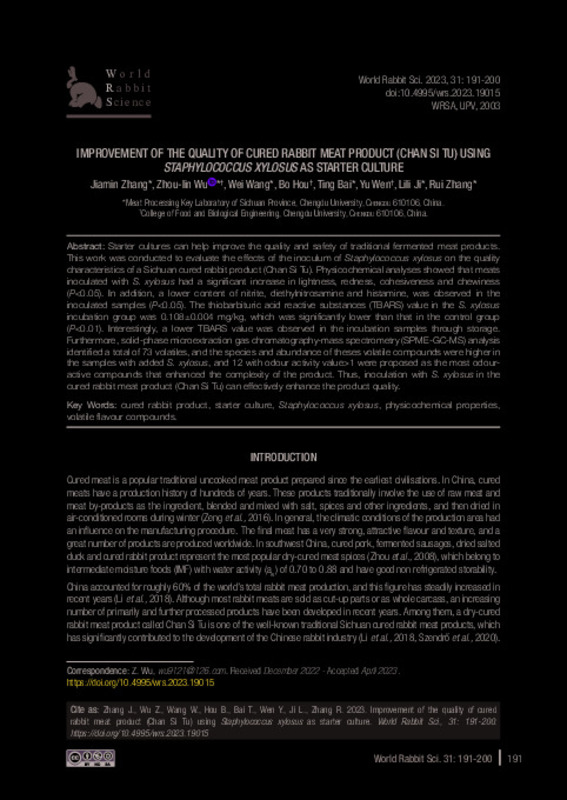Bai T., Li X., Hou B., Chen L., Wang W. 2018. Effects of complex microbial strains on volatile flavor components of Airdried rabbits. (In Chinese). Chin. Condiment, 43: 38-43. https://doi.org/10.3969/j.issn.1000-9973.2018.11.007
Barbuti S., Parolari G. 2002. Validation of manufacturing process to control pathogenic bacteria in typical dry fermented products. Meat Sci., 62: 323-329. https://doi.org/10.1016/S0309-1740(02)00124-9
Cebrián E., Núñez F., Gálvez F.J., Delgado J., Bermúdez E., Rodríguez M. 2020. Selection and evaluation of Staphylococcus xylosus as a biocontrol agent against toxigenic moulds in a dry-cured ham model system. Microorganisms, 8: 793. https://doi.org/10.3390/microorganisms8060793
[+]
Bai T., Li X., Hou B., Chen L., Wang W. 2018. Effects of complex microbial strains on volatile flavor components of Airdried rabbits. (In Chinese). Chin. Condiment, 43: 38-43. https://doi.org/10.3969/j.issn.1000-9973.2018.11.007
Barbuti S., Parolari G. 2002. Validation of manufacturing process to control pathogenic bacteria in typical dry fermented products. Meat Sci., 62: 323-329. https://doi.org/10.1016/S0309-1740(02)00124-9
Cebrián E., Núñez F., Gálvez F.J., Delgado J., Bermúdez E., Rodríguez M. 2020. Selection and evaluation of Staphylococcus xylosus as a biocontrol agent against toxigenic moulds in a dry-cured ham model system. Microorganisms, 8: 793. https://doi.org/10.3390/microorganisms8060793
Chen Q., Kong B., Han Q., Xia X., Xu L. 2017. The role of bacterial fermentation in lipolysis and lipid oxidation in Harbin dry sausages and its flavour development. LWT-Food Sci. Technol., 77: 389-396. https://doi.org/10.1016/j.lwt.2016.11.075
Coutinho de Oliveira T.L., Malfitano de Carvalho S., de Araújo Soares R., Andrade M.A., Cardoso M. das G., Ramos E.M., Piccoli R.H.. 2012. Antioxidant effects of Satureja montana L. essential oil on TBARS and color of mortadella-type sausages formulated with different levels of sodium nitrite. LWT-Food Sci. Technol. 45: 204-212. https://doi.org/10.1016/j.lwt.2011.09.006
Cruxen C.E. dos S., Funck G.D., Dannenberg G. da S., Haubert L., Marques J. de L., Kroning I.S., Chaves F.C., da Silva W.P., Fiorentini Â.M. 2017. Characterization of Staphylococcus xylosus LQ3 and its application in dried cured sausage. LWT-Food Sci. Technol., 86: 538-543. https://doi.org/10.1016/j.lwt.2017.08.045
Cruxen C.E. dos S., Funck G.D., Haubert L., Dannenberg G. da S., Marques J. de L., Chaves F.C., da Silva W.P., Fiorentini Â.M. 2019. Selection of native bacterial starter culture in the production of fermented meat sausages: Application potential, safety aspects, and emerging technologies. Food Res. Int., 122: 371-382. https://doi.org/10.1016/j.foodres.2019.04.018
Essid I., Hassouna M. 2013. Effect of inoculation of selected Staphylococcus xylosus and Lactobacillus plantarum strains on biochemical, microbiological and textural characteristics of a Tunisian dry fermented sausage. Food Control, 32: 707-714. https://doi.org/10.1016/j.foodcont.2013.02.003
Flores M., Toldra F. 2011. Microbial enzymatic activities for improved fermented meats. Trends Food Sci. Technol. 22(2-3): 81-90. https://doi.org/10.1016/j.tifs.2010.09.007
Ji L., Wang W., Zhang J., Bai T., Wang Z., Li J. 2016. Study on effects of automatic drying and use of fermentation agents on the physiochemical and microbial properties of wrapped rabbit meat. Science and Technology of Food Industry 38(2): 200-204. https://doi.org/10.13386/j.issn1002-0306.2017.02.030
Ji M., Du H., Xu Y. 2020. Structural and metabolic performance of p-cresol producing microbiota in different carbon sources. Food Res. Int. 132: 109049. https://doi.org/10.1016/j.foodres.2020.109049
Kim T.K., Kim Y.B., Jeon K.H., Park J.D., Sung J.M., Choi H.W., Hwang K.E., Choi Y.S. 2017. Effect of fermented spinach as sources of pre-converted nitrite on color development of cured pork loin. Korean J. Food Sci. Anim. Resour., 37: 105-113. https://doi.org/10.5851/kosfa.2017.37.1.105
Lee Y.C., Kung H.F., Huang C.Y., Huang T.C., Tsai Y.H. 2016. Reduction of histamine and biogenic amines during salted fish fermentation by Bacillus polymyxa as a starter culture. J. Food Drug Anal., 24: 157-163. https://doi.org/10.1016/j.jfda.2015.02.002
Li P., Luo H., Kong B., Liu Q., Chen C. 2016. Formation of red myoglobin derivatives and inhibition of spoilage bacteria in raw meat batters by lactic acid bacteria and Staphylococcus xylosus. LWT-Food Sci. Technol., 68: 251-257. https://doi.org/10.1016/j.lwt.2015.12.035
Li S., Zeng W., Li R., Hoffman L.C., He Z., Sun Q., Li H. 2018. Rabbit meat production and processing in China. Meat Sci., 145: 320-328. https://doi.org/10.1016/j.meatsci.2018.06.037
Liu X.S., Liu J.B., Yang Z.M., Song H.L., Liu Y., Zou T.T. 2014. Aroma-active compounds in jinhua ham produced with different fermentation periods. Molecules, 19: 19097-19113. https://doi.org/10.3390/molecules191119097
Michalski M., Pawul-Gruba M., Madejska A. 2021. Histamine contents in raw long-ripening meat products commercially available in Poland. J. Vet. Res., 65: 477-481. https://doi.org/10.2478/jvetres-2021-0062
Nie X., Zhang Q., Lin S. 2014. Biogenic amine accumulation in silver carp sausage inoculated with Lactobacillus plantarum plus Saccharomyces cerevisiae. Food Chem., 153: 432-436. https://doi.org/10.1016/j.foodchem.2013.12.093
Sun Q., Chen Q., Li F., Zheng D., Kong B. 2016. Biogenic amine inhibition and quality protection of Harbin dry sausages by inoculation with Staphylococcus xylosus and Lactobacillus plantarum. Food Control, 68: 358-366. https://doi.org/10.1016/j.foodcont.2016.04.021
Szendrő K., Szabó-Szentgróti E., Szigeti O. 2020. Consumers’ attitude to consumption of rabbit meat in eight countries depending on the production method and its purchase form. Foods, 9: 654. https://doi.org/10.3390/foods9050654
Wang M.Q., Ma W.J., Shi J., Zhu Y., Lin Z., Lv H.P. 2020. Characterization of the key aroma compounds in Longjing tea using stir bar sorptive extraction (SBSE) combined with gas chromatography-mass spectrometry (GC–MS), gas chromatography-olfactometry (GC-O), odor activity value (OAV), and aroma recombination. Food Res. Int., 130: 108908. https://doi.org/10.1016/j.foodres.2019.108908
Xiao Y., Liu Y., Chen C., Xie T., Li P. 2020. Effect of Lactobacillus plantarum and Staphylococcus xylosus on flavour development and bacterial communities in Chinese dry fermented sausages. Food Res. Int., 135: 109247. https://doi.org/10.1016/j.foodres.2020.109247
Xie J.C., Sun B.G., Wang S.B. 2008. Aromatic constituents from Chinese traditional smoke-cured bacon of Mini-pig. Food Sci. Technol. Int., 14: 329-340. https://doi.org/10.1177/1082013208098331
Zhou G., Luo X., Xu X., Zhao G., Liu D., Ma H., Huan Y., Sun J., Li C., Huang M., Chen T. 2008. The classification of Chinese meat products. (In Chinese). Meat Res., 10: 3-5. https://doi.org/10.3969/j.issn.1001-8123.2008.10.004
Zeng W., Wen W., Deng Y., Tian Y., Sun H., Sun Q. 2016. Chinese ethnic meat products: Continuity and development. Meat Sci., 120: 37-46. https://doi.org/10.1016/j.meatsci.2016.04.007
[-]









